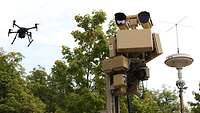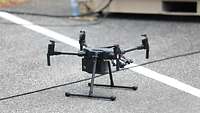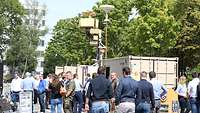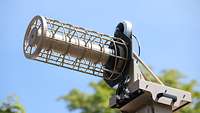New counter-drone system for camp protection fielded successfully
Equipment, Information Technology and In-Service Support- Date:
- Place:
- Koblenz
- Reading time:
- 4 MIN


At the Federal Office of Bundeswehr Equipment, Information Technology and In-Service Support (BAAINBwBundesamt für Ausrüstung, Informationstechnik und Nutzung der Bundeswehr) in Koblenz, the new counter UASUnmanned Aerial System-system called ASUL was presented to the Office’s employees.

Sighting the incoming drone: ASUL being presented at BAAINBwBundesamt für Ausrüstung, Informationstechnik und Nutzung der Bundeswehr in Koblenz
Bundeswehr/Dirk BannertHaving been procured in a fast and mission-oriented way, the system is now ready to be deployed in operations to protect soldiers in the camp from unmanned aircraft systems, only two years after the start of the project.
For some time now, the Bundeswehr has been facing the growing threat posed by small Unmanned Aircraft Systems (sUAS) or drones weighing up to 25 kg. More and more often, especially in the operational and mission areas, camps are flown over by such aircraft systems.
Most of these sUAS are home-made or civilian drones, which are not only available to everyone nowadays but also easy to handle. On the one hand, these drones are specifically used for reconnaissance flights over camps. On the other hand, they are increasingly carrying explosives to, for example, attack or assault camps.

A drone ready to take off - nowadays, such a device can be easily purchased by anyone to be used for their own purposes
Bundeswehr/Dirk BannertBeing small, extremely agile and able to reach high speeds, such drones are rather difficult to detect and are thereby posing a new challenge not only to the Bundeswehr but also to other armed forces worldwide.
This is why C-sUAS (Counter-small Unmanned Aircraft Systems) will become more and more important in the future to protect our service personnel during operations in the best way possible.
In the past, the Bundeswehr used two independent systems for countering drones in the operational areas. A detection system was deployed exclusively to identify and classify sUAS, while a shoulder-carried and battery-powered jammer would be used to defeat the target afterwards.
With the introduction of the new ASUL counter-drone system all capabilities required are bundled in a single stationary system for the first time. In such a way, small UASUnmanned Aerial System can not only be detected, classified and identified, but also defeated from a fixed location and in real time.
As a rule, every system is composed of two transportable containers.

A lively exchange taking place in front of the system’s mobile containers
Bundeswehr/Dirk BannertOne container measuring 10 feet comprises the sensor system necessary for detection and identification. This system is composed of one mast which can be extended up to five meters, three radars and a camera system with day and night vision. A radio frequency (RF) direction finder used to identify control signals and, if possible, also locate the position of the drone pilot complements the features of the container.
In the other container measuring 20 feet, the reconnaissance of and the countermeasures against sUAS are managed. A stationary and remote-controlled jammer system using electromagnetic energy is incorporated to defeat drones. Since the new jammer is no longer carried on the soldiers’ shoulders, it has a higher power output almost doubling the frequency range. Thus, these kinds of aircraft system can be defeated from a distance of several kilometers.
Once an aircraft has been detected by the radars and the direction finder, the system will compare its data with information available from data bases. In such a way, the system determines whether or not the aircraft could be a drone.
After an alleged target has been detected, the system’s operator will be informed in real time und will be able to verify, with the help of the camera system, if the drone is to be classified as a threat. In doing so, the system is able to identify if the target is, for example, an intelligence gathering drone or an aircraft system loaded with explosives.

The system’s jammer is able to counter small Unmanned Aircraft Systems (sUAS) at some distance
Bundeswehr/Dirk BannertThe drone can then be neutralized by aiming the jammer at the target. To this end, a signal interfering with, blocking or superimposing the radio communication between the drone and its control device will be sent. This signal forces the drone to pause in mid-air where it can be neutralized subsequently depending on its threat potential.
BAAINBwBundesamt für Ausrüstung, Informationstechnik und Nutzung der Bundeswehr purchased five ASUL systems in total. The first system is already in use in Todendorf as a training system, while the remaining four systems are intended to ensure camp protection during operations.
In Germany, ASUL was already deployed successfully at the G7Gruppe der Sieben Summit at Schloss Elmau for the first time. On this occasion, the Bundeswehr helped to secure the airspace by successfully detecting drones to be neutralized by the Federal Criminal Police Office and the Federal Police.
C-sUAS project manager, Dr. Hendrikje N., was full of praise for the team: “Even though the Bundeswehr is breaking some new ground with this technology, the ASUL project team at BAAINBwBundesamt für Ausrüstung, Informationstechnik und Nutzung der Bundeswehr has procured the counter-drone system with a great deal of commitment (...) cooperating closely with other organizational units. For this reason, Germany is one of the few European countries with a comparatively strong counter-drone system. For us, this system marks the beginning of a new and exciting era for air defense.”
by PIZ AIN